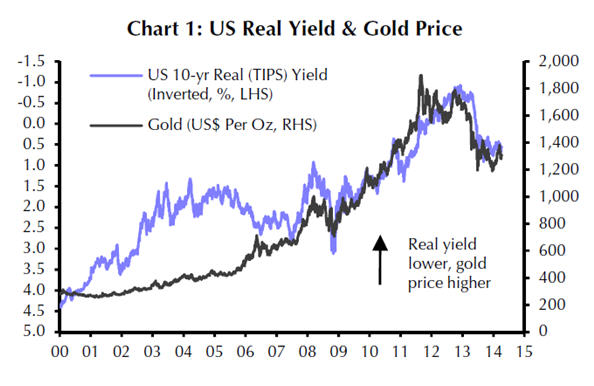The case for higher US interest rates AND higher gold
A number of gold market analysts have made the case that the one major factor influencing the price of gold is US inflation-adjusted interest rates.
Some analysts go so far as to say that the correlation is so strong that the gold price can be used as a predictor of interest rates, serving as an early warning system of both the direction and magnitude of the move in rates.
In a new research note Julian Jessop Head of Commodities Research at Capital Economics published a graph showing just how strong the inverse correlation is between US 10-year real yields (Treasury Inflation Protected Securities or TIPS) and the price of gold:
The underlying reason for the relationship is that as yields rise – as is expected in the US – the opportunity costs of holding gold increases because the metal is not income producing.
Higher rates also boost the value of the dollar which usually move in the opposite direction of the gold price.
The independent macro-economic research house notes that “taking this first chart entirely at face value, the eventual return of US real yields to more normal levels of around 2% would be consistent with the gold price falling back below $1,000 per ounce.”
That said, Capital Economics argues that there are a sufficient number of other factors at play in the gold market that improves the outlook for gold:
- The Fed is likely to be purchasing additional assets (and hence adding stimulus) until late this year and it may still be several years before US monetary policy is normalized
- Even if real yields were unchanged, gold prices might be expected to rise in nominal terms both because of general inflation and rising costs in the mining industry
- Other globally important central banks are still likely to ease monetary policy further, notably the Bank of Japan but probably also the ECB
- Physical demand from emerging markets, which when robust enough break down the correlation with real yields (see 2000 to 2007 on the chart), particularly when India eases import restrictions
- Safe-haven demand (due to geopolitical risks and equity market volatility)
“The upshot is,” writes Jessop, “we are sticking with our end-2014 forecast of $1,450.”
Image by artemuestra
{{ commodity.name }}
{{ post.title }}
{{ post.date }}





Comments